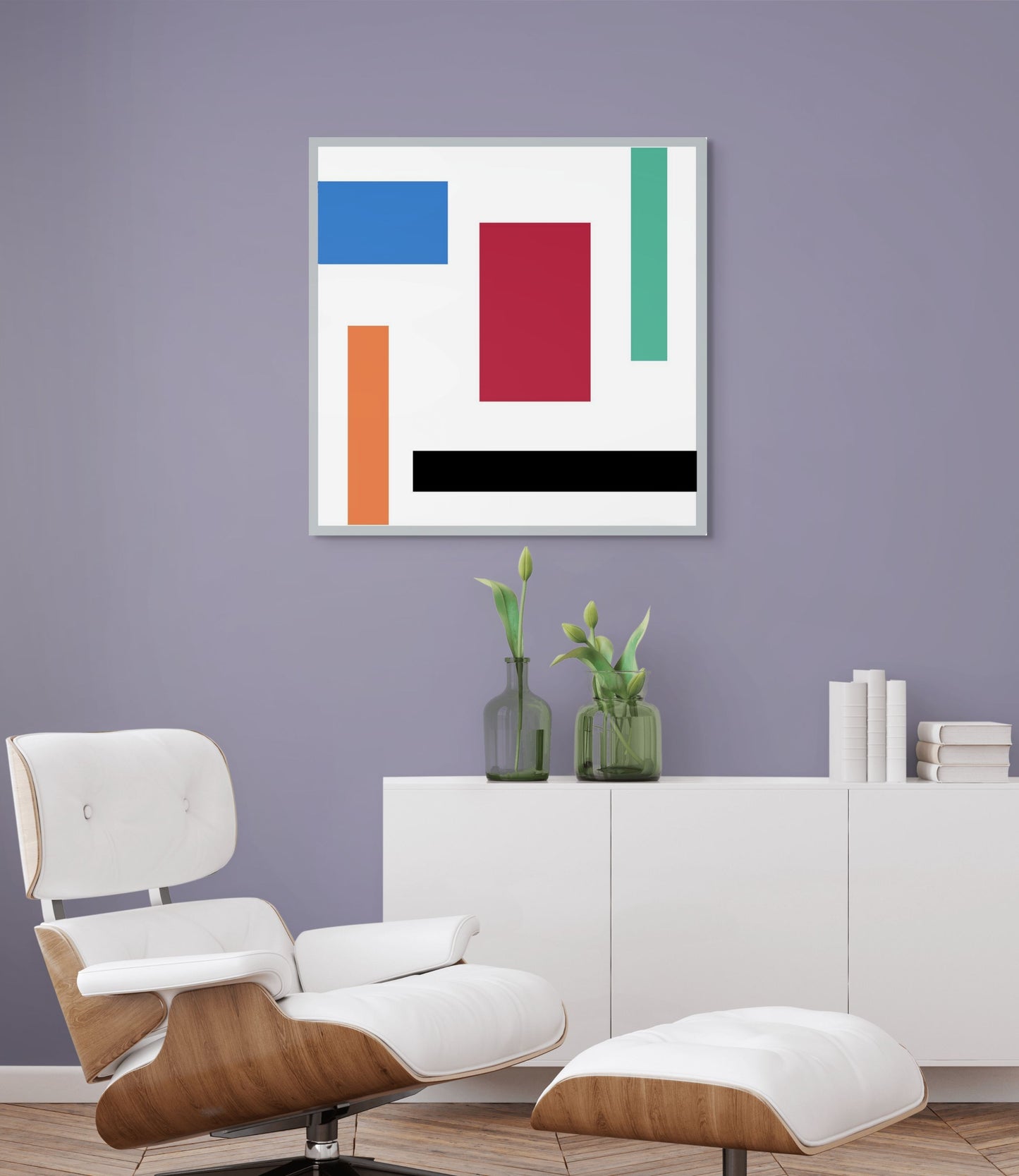The Power of Red Red 36" x 36"
The Power of Red Red 36" x 36"
See more paintings from the Floating Color Collection.

James Nowak’s The Power of Red, from his Floating Color Collection, is a striking meditation on the authority of color within the language of abstraction. Centered around a dominant crimson rectangle, the painting explores how one hue—when strategically positioned and scaled—can assert presence, command space, and reshape relationships between surrounding forms. While maintaining the buoyancy and openness characteristic of the collection, this work intensifies the dialogue between strength and harmony, between visual dominance and equilibrium.
At the heart of the painting lies a large vertical red rectangle, positioned centrally as the commanding force of the composition. Around it, other geometric forms—an orange vertical bar, a teal-green vertical bar, a cobalt-blue horizontal rectangle, and a long black horizontal bar—both orbit and yield to its dominance.
The arrangement is asymmetrical yet balanced. The red form stands upright, like a pillar or monolith, while the supporting bars create a scaffold of tension and counterbalance. The black horizontal at the bottom reinforces weight and grounding, while the lighter blue and teal bars contribute verticality, preventing the red rectangle from overwhelming the canvas.
The interplay of horizontals and verticals creates an architectural feel, yet without rigidity. Instead, the work feels like an abstract theater in which red plays the lead role while other colors perform as supporting cast.
The title foregrounds red as the central agent of meaning. In art history, red is a color of passion, vitality, power, and urgency. Here, the red rectangle does not merely occupy space—it defines it. Its centrality, scale, and saturation command the eye, forcing all other shapes into relation with it.
Red becomes a metaphor for presence—whether human, emotional, or structural. It embodies strength but also responsibility: its dominance requires counterweights (black, teal, blue, orange) to prevent collapse into singularity.
The palette demonstrates Nowak’s signature bold contrasts:
- Red: dominant, radiating authority, intensity, and emotional heat.
- Black: grounding, serious, and stabilizing, countering red’s vibrancy.
- Blue: calm and steady, introducing coolness to balance intensity.
- Teal-green: refreshing, suggesting renewal or resilience.
- Orange: energetic and dynamic, amplifying red while also softening its potential harshness.
The white background reinforces the floating sensation, ensuring the colors resonate as luminous, untethered presences rather than flat blocks of pigment.
As in the other works of the Floating Color Collection, the shapes hover in space, weightless against the white field. Yet unlike Sunshine or Blue Line, where levity dominates, The Power of Red emphasizes weight and gravity. The red rectangle does not drift; it anchors. The floating quality exists, but it is tensioned by the sheer solidity of red.
This interplay between float and anchor deepens the work’s resonance—it is both buoyant and monumental, both suspended and immovable.
The painting vibrates with intensity. The central red rectangle embodies power, but not aggression; it is tempered by the supporting roles of other hues. The composition suggests themes of leadership, influence, and interdependence. Red is powerful, but its power exists only in dialogue with the other colors.
Symbolically, the work can be read as an allegory of human dynamics: the individual (red) commands presence but requires community (the other forms) to sustain balance.
Nowak’s abstraction resonates with the legacy of Mondrian and Malevich, where color and geometry served as universal languages. Yet The Power of Red diverges in its embrace of emotion. While Mondrian sought equilibrium through neutrality of primaries, Nowak allows red to dominate emotionally, recalling Barnett Newman’s zips or Mark Rothko’s chromatic intensity.
By framing red as both anchor and energy, Nowak positions himself between structural modernism and expressive abstraction.
James Nowak’s The Power of Red exemplifies how a single color, carefully deployed, can transform an entire composition. Through bold geometry, dynamic balance, and chromatic authority, the work reveals red as both force and metaphor—an emblem of vitality, presence, and power. In anchoring floating abstraction with a commanding central figure, Nowak elevates geometry into a meditation on strength, interdependence, and the commanding role of color in shaping perception.

